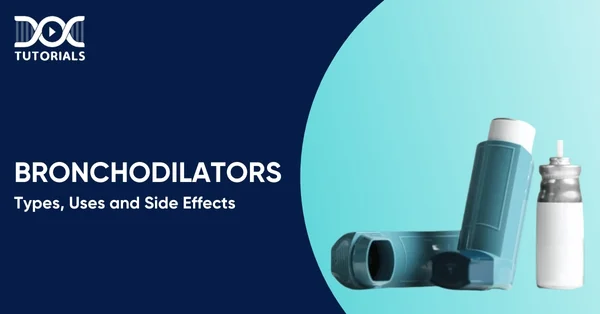Bronchodilators | Types, Uses, and Side Effects

Bronchodilators are medicines used to treat respiratory conditions like asthma and chronic obstructive pulmonary disease (COPD), which cause the airways to narrow and become inflamed. These drugs relax the muscles surrounding the airways to facilitate breathing and aid in managing symptoms such as wheezing, coughing, and shortness of breath.
For millions of people with chronic lung conditions, bronchodilators have improved their quality of life. However, safe and effective treatment requires knowledge of their types, applications, side effects, and required precautions. If you’re a medical student preparing for the NEET PG exam, it is crucial to understand Bronchodilators in depth.
Keep reading for a detailed insight.
What are Bronchodilators and Their Types?
Bronchodilator drugs help relax and widen the bronchial muscles to open up the airways and make it easier for air to enter and exit the lungs. They are mainly categorised according to how they work and how long they last, as per the following:
- Beta-2 Agonists
These medications relax the airway muscles by activating beta-2 receptors. They are of 2 types:
- SABAs, or short-acting beta-2 agonists, are often referred to as “rescue inhalers.” They offer prompt alleviation of acute symptoms. Levalbuterol and albuterol are two examples of Beta-2 Agonists.
- LABAs, or long-acting beta-2 agonists, are used to prevent and control symptoms over the long term. Formoterol and salmeterol are two examples.
- Anticholinergics (Muscarinic Antagonists)
These inhibit the neurotransmitter acetylcholine, which causes the muscles in the airways to contract.
- Ipratropium is one example of a short-acting anticholinergic.
- Tiotropium and aclidinium are examples of long-acting anticholinergics.
- Methylxanthines
Theophylline, which relaxes airway muscles via a different mechanism, is the most widely used bronchodilator. Theophylline is rarely used and is usually available as an oral tablet because of its potential for severe side effects and the requirement for blood monitoring.
Some common ways to deliver bronchodilators are as follows:
- MDIs, or metered dose inhalers
- Inhalers with dry powder
- Nebulisers, which transform liquid solutions into mists
- Oral medications, primarily theophylline
What are the Uses of Bronchodilators?
Bronchodilators are primarily used to manage and treat conditions that cause airway narrowing and inflammation, such as:
- Asthma
Both short-acting and long-acting bronchodilators are used for asthma. Inhaled corticosteroids remain the mainstay, but bronchodilators are added to control symptoms and prevent flare-ups. To lower the risk of severe asthma attacks, long-acting bronchodilators should always be used along with corticosteroids.
- Chronic Obstructive Pulmonary Disease (COPD)
Bronchodilators are the first-line treatment for COPD. They increase airflow and reduce symptoms. Both short—and long-acting forms are used, sometimes in combination with corticosteroids in more severe cases.
- Other Respiratory Conditions
Bronchodilators may also be used to ease breathing difficulties in children with bronchitis, emphysema, pneumonia, and bronchiolitis.
They are not typically effective for people with respiratory symptoms from smoking who have not been diagnosed with COPD.
What are the Side Effects of Bronchodilators?
Side effects of bronchodilators may vary by drug class, route of administration, and individual patient factors. The side effects are usually mild, but some can be serious. Here are some bronchodilators drugs names and their side effects:
Beta-2 Agonists
- Tremors, especially in the hands
- Nervousness or anxiety
- Headache
- Palpitations (awareness of heartbeat)
- Rapid heart rate
- Muscle cramps
- Hyperactivity, especially in children
Rare side effects include the following:
- Serious allergic reactions
- Abnormal heart rhythms
Anticholinergics
- Dry mouth
- Cough
- Headache
- Nausea
- Dizziness
Rare side effects include the following:
- Difficulty urinating
- Blurred vision
- Constipation
Methylxanthines (Theophylline)
- Nausea and vomiting
- Insomnia
- Headache
- Heart palpitations
- Seizures (in case of overdose or high blood levels)
- Older adults are at higher risk of side effects due to slower drug clearance.
What are the Precautions to Follow While Taking Bronchodilators?
To ensure safe and effective use of bronchodilators, consider the following precautions:
- Follow Prescriptions Strictly
Use bronchodilators only as prescribed by the healthcare provider. Do not exceed the recommended dose, as overuse can lead to serious side effects.
- Monitor for Interactions
Bronchodilators, especially theophylline, can interact with other medications, increasing the risk of adverse effects. Always let the doctor know about all of the medicines the patient uses.
- Proper Technique
Learn and practice the correct technique for inhaler or nebuliser use to maximise drug delivery to the lungs.
- Special Populations
Pregnant or breastfeeding women should consult their doctor before use. Asthma control during pregnancy is crucial for maternal and foetal health.
- Monitor Side Effects
Inform the healthcare provider of any severe or ongoing side effects. Other drugs or dose changes might be required.
- Avoid Sharing
Never share the inhaler or medication with others, even if they have similar symptoms.
- Regular Monitoring
Some medications, like theophylline, require blood tests to ensure safe levels, especially in older adults.
- Avoid Eye Contact
Avoid getting the medication for inhaled anticholinergics in the eyes, as it can blur vision or cause eye pain.
FAQs About Bronchodilators
- Who else can use bronchodilators other than people with asthma and COPD?
Bronchodilators may also help manage breathing difficulties in children with conditions such as bronchitis, emphysema, pneumonia, and bronchiolitis.
- How quickly do bronchodilators start working, and how long do they last?
Short-acting bronchodilators typically begin working within minutes and last for 4–6 hours. However, long-acting bronchodilators may take longer to start but provide relief for up to 12–24 hours.
- Are there dietary or lifestyle restrictions while using bronchodilators?
Some bronchodilators, especially theophylline, can interact with caffeine and certain foods, potentially increasing side effects. If prescribed these medications, discussing the dietary habits with a healthcare provider is advised.
- Can bronchodilators be used during exercise to prevent symptoms?
Yes, short-acting bronchodilators are often used before exercise to prevent exercise-induced bronchospasm in people with asthma.
- What to do upon missing a dose of my bronchodilator?
It is advised to take the missed dose as soon as it is recalled. If it is almost time for the next dose, skip the one missed and take it as planned. Don’t take twice as much to catch up. For precise instructions, always check with a healthcare practitioner.
Conclusion
Bronchodilator drugs help manage respiratory diseases and are a crucial topic for the NEET PG syllabus. Thus, it requires both clinical and pharmacological understanding. Adequate knowledge of their types, uses, and side effects is essential for exam success and future clinical practice.
With DocTutorials, you can access comprehensive resources like video lectures, high-yield notes, and practice MCQs tailored to NEET PG needs. This makes complex topics like bronchodilators easy to grasp, helping aspirants excel in their exams.
For top-level success, join our NEET PG course today!
Latest Blogs
-

NEET SS Exam 2024: Analysis, Key Dates, Counselling
The NEET SS 2024 exam kicked off on March 29, 2025. Over two days and two slots, candidates across 13…
-

NEET PG Registration 2025: An Essential Guide For Exam Prep
The NEET PG registration, which is conducted online, is a crucial step in the exam process. Filling out the NEET…
-

NEET PG Syllabus 2026: A Must-Have Complete Guide for Exam Success
The NEET PG Syllabus acts as one of the foundation stones for aspiring postgraduate medical students like you who are…




